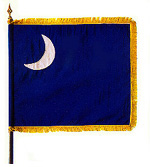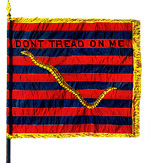South Carolina History
 |
 |
| |
[image courtesy of Son of the Revolution. Copyright (c) 1998 SR.] |
 |
 |
| |
[image courtesy of Son of the Revolution. Copyright (c) 1998 SR.] |
South Carolina was a major player in the role toward American independence from England. There were several contingence of individuals here with different views of what independence meant and whether George III, King of England who reigned from 1760 to 1820, was responsible for their problems. The people of Charles Town (now Charleston) were particularly unhappy about the taxation of goods being imported into the colonies since they had large numbers of traders. The more remote areas of western South Carolina were more concerned about protection from the indians and were not impacted so much by the taxes on importation since they were largely self-sufficient. They also may have felt that the British as their protectors deserved to tax for this service. The history that I will develop here is how my own relatives survived and dealt with the hardship and changes of the times.
The Nonassociators were a group of South Carolina legislators that had decided not go along with the call for independence. The Nonassociators, also known as the Counter-Association, had believed that King George "had not acted inconsistent with subversive of the principles of the Constitution of the British Empire," and that they saw no reason to "take up arms against him" or to renounce allegiance to him. [McMaster 36]
Moses Kirkland was one of the individuals who had originally signed up for the South Carolina Militia and resigned his commission to fight on the side of the British. As William Henry Drayton and Reverend William Tennet went around the countryside trying to whip up support for the Provincial Congress Moses Kirkland followed to give his views and convinced many that it was against their best interests to get involved with the call for independence. He carried word of support back to the Governor of South Carolina of support in the wilderness areas and helped convince the British that South Carolina could win the fight to retain the connection to the mother country. Moses Kirkland was sent north with this message but was captured with his young son. His documents and letters were seized and published making him an enemy of the revolutionary forces. He and his son were imprisoned near Baltimore but later escaped to Jamaica.
It seems certain regions were either for or against the cause for separation. Edgefield county, the home of the Kirkland families, seems to have been a center for non-separation or for the British whereas Laurens, Greenville, and Abbeville counties seemed to have more need for independence. According to Edward McChady "History of South Carolina",
Col. Andrew Williamson, whose home was at White Hall in Abbeville county, commanded the American forces amounting to 562 men. Colonel Robinson commanded the Tory, or Loyalist, forces of 1,892 men. In the return made the provincial congress of the militia and volunteers in this fortified camp at Ninety-Six, Sunday, November 19, 1775, there are among the names of officers those of Andrew Hamilton, Andrew Pickens, George Reed, Thomas Langdon (grandfather of distinguished Langdon Cheves), Adam Crane Jones, Nathaniel Abney and Robert Anderson. These were captains, and in all there were 25 of them.
The Americane had one killed and 12 wounded, the British 20 killed and wounded.
An engagement was fought at Cherokee Ford, on the Savannah river. two miles below where the thriving town of Calhoun Falls is now situated. Colonel Boyd commanded the Loyalists, numbering 100. The Americans were commanded by Col. Robert Anderson, who had a small force, which was taken by surprise and 16 men killed and 16 taken prisoners into Georgia.
In the battle of Long Cane, which occurred December 11,1780. Colonel Clarke commanded the American forces and had 14 killed and seven wounded. Colonel Allen commanded the British force of 450 and had three killed and three wounded. The handle of a broken sword has been found near Long Cane creek where the Federal bridge crosses the stream. Everything indicates that this battle was fought at what was then the Long Cane Ford on the road from Ninety-Six to the present Abbeville by the Calhoun highway.
The engagement at Hammond's store on Saluda river, in Abbeville county, was fought December 30, 1780. The Americans were commanded by Col. William Washington with 275 superbly mounted men. After a march of 40 miles, Colonel Washington charged the British. It was a fight and not a fight. The killed and wounded were 150 and 40 prisoners. The name of the officer commanding the Loyalist troops in this action is not given.
From may 12, 1781, till June 19, General Greene with 1,000 American troops besieged the British in the star Fort at Ninety-Six court house. The 500 British commanded by Colonel Cruger were within entrenched walls, During the siege General Greene lost 135 men and the British 85 in killed and wounded. General Greene had cut off the water supply of the garrison and having no cannon to batter down the fort, decided to run a tunnel beneath it and blow it up with gunpowder. News reached the British that Lord Rawdon was coming with reinforcement. General Greene was forced to raise the siege. The well the British dug can still be seen, also the tunnel dug by General Greene's command can still be entered. This battle is called the "Siege of Ninety-Six."
The engagement at Beattle's Mill was an important one, the Americans were commanded by Colonel Pickens, Colonel Clarke of Georgia and Colonel McCall. These officers had been recalled from North Carolina to defend the back settlements of South Carolina, which were in continual danger from the Indian incursions and daily danger from the raiding Loyalists from the entrenched camp at Ninety-Six. As Pickens was pursuing his march he received the news that Major Dunlap with 75 British dragoons had been sent out from Ninety-Six on a foraging expedition. March 24 they met Dunlap at Beattie's Mill on Little River (thought to be the present Martin's Mill).
Dunlap entrenched himself in the mill
and
nuthouses and resisted for several hours. After 34 of his men
had been
killed
and others wounded, himself among the latter, he sent out a flag
of
truces
and surrendered."
[Wallace, D. D.
The
History
of South Carolina, p.16]
Other relatives involved in the Continental army or militia include Henry Machen, of Greenville County, who served with Capt. Moses Wood's company of Horse in Colonel Roebuck's regiment of the South Carolina Militia. At least one of his sons, John Seaborn Machen, also served in the militia. Adam C. Jones was commanding a company of 2 officers, 2 sergeants, and 22 privates at a fortified camp in the Ninety-Six district on Sunday, November 19, 1775. [Chapman 57] Maurice Ronie served as a Sgt. with the Second Dragoons under Captain Francis Moore, Col. Myddleton and Gen. Sumter during 1781. He also served as a footman and was wounded in the battle of Eutaw Springs. He was also present at the battle of Guilford Courthouse in N.C. [Roll 128 and on frame 8699 at the National Archives]
Less formal organizations were created for mutual protection than the revolutionary army. Some researchers have in the past listed one of these as organized by Hewlett Sullivan, although he would have only been about 18 years old. See the article opposing this research by Deason Smith on the Sullivan Independent Volunteers.
At the conclusion of the war much work had to be done to form a new government. Adam Crain Jones was elected as a delegate from Abbeville, South Carolina to the South Carolina Constitutional Convention which met in Charleston from May 12, 1788 until it was adopted FRIDAY, May 23, 1788.
More on the Battle of Cowpens and Kings Mountain.
Moses Kirkland, James, John, Benjamin and Aaron Kirkland
Elroy's Family Index | Chart #1 | Surname Index | Regional History Index






All information and
photos
included within these pages was developed by the
help of hundreds of
researchers. The information here is for the express
purpose of
personal genealogical research and is freely offered
as long as this
site is listed as a source. It may not be included
or used for any
commercial purpose or included in any commercial
site without the
express permission of Elroy Christenson. Copyright
Elroy Christenson
1998-2010.